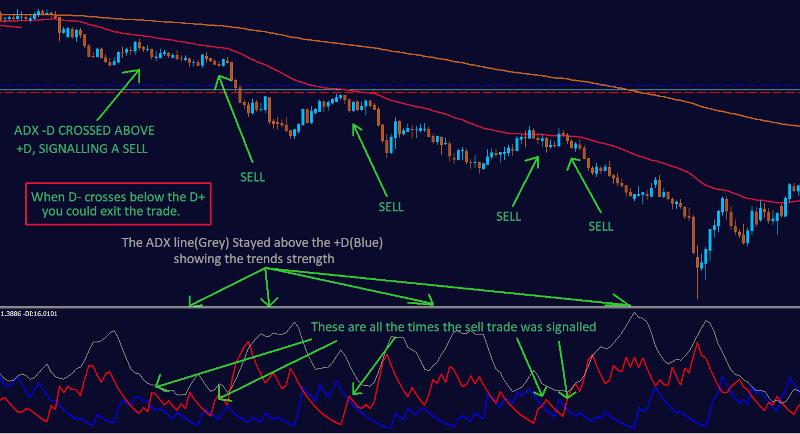Average Directional Index (ADX) Strategy Explained
The Average Directional Index (ADX) Strategy is a technical analysis technique that helps traders assess the strength of a trend and identify potential trend reversal points. This strategy is based on the ADX indicator, which provides insights into the strength and momentum of a market trend.
Understanding the Average Directional Index Indicator
The Average Directional Index (ADX) indicator consists of three lines: the ADX line itself, the +DI (Positive Directional Indicator) line, and the -DI (Negative Directional Indicator) line. The ADX line reflects the strength of the trend, while the +DI and -DI lines indicate the direction of the trend.
How the Strategy Works
The ADX Strategy involves interpreting the ADX line and its interaction with the +DI and -DI lines:
- ADX Line: When the ADX line is rising, it suggests the strength of the trend is increasing. A higher ADX value indicates a stronger trend, and a lower value suggests a weaker trend or a range-bound market.
- +DI and -DI Lines: The +DI line crossing above the -DI line can indicate a potential bullish trend, while the -DI line crossing above the +DI line can suggest a potential bearish trend.
- ADX Level: Traders often use a specific ADX level (e.g., 25) as a threshold. If the ADX is above this level, it suggests a strong trend, and if it's below, it indicates a weaker trend or a range-bound market.
Examples
Let's explore examples of the Average Directional Index Strategy:
Strong Trend Confirmation:
If the ADX line is rising and above the threshold level (e.g., 25), it suggests a strong trend. Traders might consider holding positions in the direction of the trend, as the momentum is favorable.

Trend Reversal Signal:
If the +DI line crosses above the -DI line, it might signal a potential bullish trend reversal. Conversely, if the -DI line crosses above the +DI line, it might indicate a potential bearish trend reversal. Traders could consider adjusting their positions accordingly.
Combining with Other Indicators
Traders often combine the ADX Strategy with other technical indicators, such as moving averages, to validate signals and enhance the accuracy of their trading decisions.
Average Directional Index (ADX) Indicator Based Trading Strategies
1. ADX Trend Strength Strategy:
- Monitor the ADX line to gauge the strength of a trend.
- Enter trades when the ADX line is rising and above a certain threshold (e.g., 25), indicating a strong trend.
2. ADX Trend Reversal Strategy:
- Look for the ADX line to decline from high levels, suggesting a weakening trend.
- Consider entering trades when the ADX line drops below a certain threshold and then starts to rise again, indicating a potential trend reversal.
3. ADX and Directional Movement Strategy:
- Combine the ADX line with the Plus Directional Indicator (+DI) and Minus Directional Indicator (-DI).
- Enter trades when the +DI crosses above the -DI and the ADX is rising, indicating a potential uptrend.
- Enter trades when the -DI crosses above the +DI and the ADX is rising, indicating a potential downtrend.
4. ADX and Moving Averages Strategy:
- Combine the ADX with moving averages to confirm trend direction.
- Enter trades in the direction of the trend when the ADX is rising and aligned with the moving average's direction.
5. ADX and Volatility Breakout Strategy:
- Monitor the ADX to identify periods of increasing volatility.
- Look for breakouts above resistance or below support when the ADX indicates strong market movement.
6. ADX Pullback Strategy:
- Wait for the ADX to show a strong trend, indicating a pullback might be a retracement rather than a reversal.
- Enter trades in the direction of the original trend after the pullback has occurred.
7. ADX Range Expansion Strategy:
- Observe periods of low ADX values, indicating a lack of trend.
- Consider entering trades when the ADX starts to rise from low levels, indicating a potential trend development.
8. ADX Divergence Strategy:
- Look for divergences between the ADX and price movement.
- If the ADX makes higher highs while the price makes lower highs, or vice versa, it might signal a potential trend reversal.
9. ADX Breakout and Retest Strategy:
- Wait for the ADX to show a strong trend, indicating a potential breakout.
- After the breakout, wait for a retest of the breakout level to confirm its strength before entering a trade.
10. ADX and Support/Resistance Strategy:
- Combine the ADX with support and resistance levels.
- Enter trades when the ADX indicates strong momentum near a significant support or resistance level.
Conclusion
The Average Directional Index (ADX) Strategy is a valuable tool for assessing the strength of a trend and identifying potential trend reversal points. By understanding the ADX line and its interactions with the +DI and -DI lines, traders can make more informed decisions related to trend direction and market momentum.